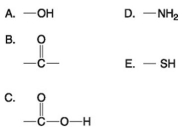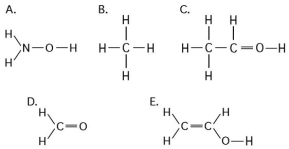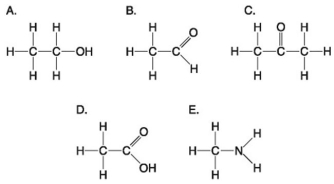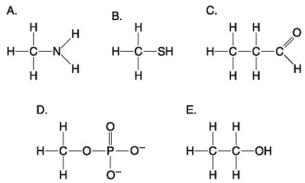A) at least one carboxyl group.
B) at least one amino group.
C) at least one hydroxyl group.
D) both an amino and a carboxyl group.
E) both an hydroxyl and a carboxyl group.
Correct Answer

verified
Correct Answer
verified
Multiple Choice
Which model best depicts a molecule's volume?
A) atomic
B) molecular
C) structural
D) ball-and-stick
E) space-filling
Correct Answer

verified
Correct Answer
verified
Multiple Choice
Which of the pairs of molecular structures shown below do not depict enantiomers (enantiomeric forms) of the same molecule?
A) ![]()
B) ![]()
C) ![]()
D) ![]()
E) ![]()
Correct Answer

verified
Correct Answer
verified
Multiple Choice
Use the following figure to answer the questions below.
 -Which functional group shown above is characteristic of alcohols?
-Which functional group shown above is characteristic of alcohols?
A) A
B) B
C) C
D) D
E) E
Correct Answer

verified
A
Correct Answer
verified
Multiple Choice
Which functional groups can act as acids?
A) amino and sulfhydryl
B) carbonyl and carboxyl
C) carboxyl and phosphate
D) hydroxyl and aldehyde
E) ketone and amino
Correct Answer

verified
C
Correct Answer
verified
Multiple Choice
A compound contains hydroxyl groups as its predominant functional group.Which of the following statements is true concerning this compound?
A) It lacks an asymmetric carbon, and it is probably a fat or lipid.
B) It should dissolve in water.
C) It should dissolve in a nonpolar solvent.
D) It won't form hydrogen bonds with water.
E) It is hydrophobic.
Correct Answer

verified
Correct Answer
verified
Multiple Choice
Of the biologically important functional groups listed below,which is not reactive but serves as a tag or marker?
A) hydroxyl
B) carboxyl
C) amino
D) sulfhydryl
E) methyl
Correct Answer

verified
E
Correct Answer
verified
Multiple Choice
Use the following figure to answer the questions below.
 -Which of the groups shown above is a carbonyl functional group?
-Which of the groups shown above is a carbonyl functional group?
A) A
B) B
C) C
D) D
E) E
Correct Answer

verified
Correct Answer
verified
Multiple Choice
Use the following figure to answer the questions below.
 -Which of the structures illustrated above cannot form hydrogen bonds with water molecules?
-Which of the structures illustrated above cannot form hydrogen bonds with water molecules?
A) A
B) B
C) C
D) D
E) E
Correct Answer

verified
Correct Answer
verified
Multiple Choice
Use the following figure to answer the questions below.
 -Which molecule shown above has a carbonyl functional group in the form of an aldehyde?
-Which molecule shown above has a carbonyl functional group in the form of an aldehyde?
A) A
B) B
C) C
D) D
E) E
Correct Answer

verified
Correct Answer
verified
Multiple Choice
Research indicates that ibuprofen,a drug used to relieve inflammation and pain,is a mixture of two enantiomers,that is,molecules that
A) have identical chemical formulas but differ in the branching of their carbon skeletons.
B) are mirror images of one another.
C) exist in either linear chain or ring forms.
D) differ in the location of their double bonds.
E) differ in the arrangement of atoms around their double bonds.
Correct Answer

verified
Correct Answer
verified
Multiple Choice
What determines whether a carbon atom's covalent bonds to other atoms are in a tetrahedral configuration or a planar configuration?
A) the presence or absence of bonds with oxygen atoms
B) the presence or absence of double bonds between the carbon atom and other atoms
C) the polarity of the covalent bonds between carbon and other atoms
D) the presence or absence of bonds with nitrogen atoms
E) the solvent that the organic molecule is dissolved in
Correct Answer

verified
Correct Answer
verified
Multiple Choice
What is the abbreviated structural formula good at showing?
A) The carbon skeleton and functional groups of complex organic molecules.
B) Multiple sequential stereocentres.
C) Functional groups directly above or below the carbon ring atom.
D) Axial and equatorial positioning of functional groups.
E) Stereochemistry.
Correct Answer

verified
Correct Answer
verified
Multiple Choice
What is an important source of the molecular complexity and diversity of living matter?
A) The unique properties of water.
B) The variation in carbon skeletons.
C) The non-polar nature of hydrocarbons.
D) The diversity of elements on Earth.
E) Evolution.
Correct Answer

verified
Correct Answer
verified
Multiple Choice
Use the following figure to answer the questions below.
 -Which molecule(s) shown above is (are) ionized in aqueous solution at pH 7?
-Which molecule(s) shown above is (are) ionized in aqueous solution at pH 7?
A) A
B) B and D
C) D and E
D) D
E) E
Correct Answer

verified
Correct Answer
verified
Multiple Choice
Use the following figure to answer the questions below.
 -Which molecule shown above contains an amino functional group,but is not an amino acid?
-Which molecule shown above contains an amino functional group,but is not an amino acid?
A) A
B) B
C) C
D) D
E) E
Correct Answer

verified
Correct Answer
verified
Multiple Choice
Which of the following is a false statement concerning amino groups?
A) They are basic in pH.
B) They are found in amino acids.
C) They contain nitrogen.
D) They are nonpolar.
E) They are components of urea.
Correct Answer

verified
Correct Answer
verified
Multiple Choice
Use the following figure to answer the questions below.
 -Which molecule shown above can form a dimer linked by a covalent bond?
-Which molecule shown above can form a dimer linked by a covalent bond?
A) A
B) B
C) C
D) D
E) E
Correct Answer

verified
Correct Answer
verified
Multiple Choice
Use the following figure to answer the questions below.
 -In which of the structures illustrated above are the atoms bonded by ionic bonds?
-In which of the structures illustrated above are the atoms bonded by ionic bonds?
A) A
B) B
C) C
D) C, D, and E only
E) none of the structures
Correct Answer

verified
Correct Answer
verified
Multiple Choice
Which model best depicts the angles between atoms in a molecule?
A) atomic
B) molecular
C) structural
D) ball-and-stick
E) space-filling
Correct Answer

verified
Correct Answer
verified
Showing 1 - 20 of 86
Related Exams